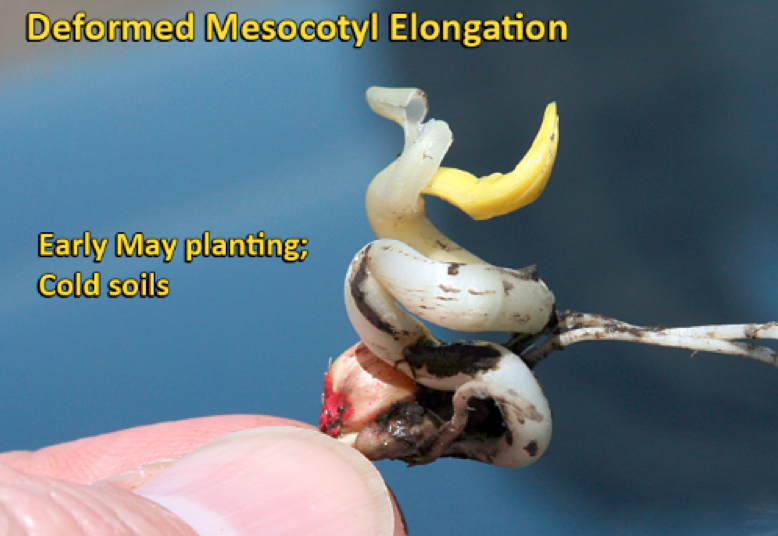Update from the Field: Corn-fused
Posted by David Dyson, Agronomist on May 15, 2018
This post may reference products and/or services only available to our Retail Farm Center customers. For more information contact your Territory Manager at The Andersons.
The most important pass a farmer can make across the field is the planting pass, but success does not stop with one single event. Plant spacing and emergence timing are critical in yield determination and there are many factors that must occur to achieve uniform spacing and emergence. The planter can have a great influence on seed spacing and emergence, but there are other factors involved, too. Seedling emergence happens as a result of elongation of the mesocotyl, pushing the tip or spike toward the soil surface. If everything goes correctly, the appearance of the spike at the surface of the soil will coincide with emergence of the first true leaf (Figure 1). If the mesocotyl elongation gets stopped or impeded, it may start growing into a corkscrew configuration (Figure 2). This could lead to leaves emerging underground or a complete failure to emerge.
Cold, wet soils or wide fluctuations in soil temperatures throughout the day during the emergence process can contribute to the development of a confused or corkscrew-looking mesocotyl. In the last couple of weeks, we have had air temperatures moving as low as 40 degrees Fahrenheit during the early morning and as high as 80 degrees Fahrenheit in the late afternoon. Soil temperatures have also had a wide fluctuation these past few weeks.
A hard or crusted surface soil layer can restrict the mesocotyl from emerging properly. This can be caused by several different factors. An excessive amount of rain can cause soil crusting at the surface. Wet soil conditions at planting can cause severe sidewall compaction plus press wheel compaction over the furrow.
Herbicides, acetochlor especially, can affect mesocotyl root development if the seedling’s growth conditions are slowed due to weather or soil conditions. When herbicide injury is suspected to be the culprit, however, cool soils and dense soil crusting are often also contributing factors, making it difficult to pin the blame completely on the herbicide injury.
In conclusion, spacing and emergence are two very important yield predictors. The planter pass is the most important field pass the farmer can make, but good yields are not determined from one event. Just as the planter pass cannot influence yields 100 percent, it is not always the herbicide’s fault when poor corn stands occur. There can be other factors at play. Digging a few seedlings up can uncover the real problem.
Takeaway Bullets:
- Planters can be, but are not always, to blame for poor emergence
- Check air and soil temperatures two weeks after planting
- Look for hard or crusted surface soil
- Ask if and which herbicides have been applied
- Most importantly, dig up the seed to investigate!

Figure 1: Newly emerged or "spiked" corn. Picture taken six days after planting south of Walton, IN.

Figure 2: This picture illustrates a corkscrew corn emergence. Taken by Dr. Robert Nielsen, Purdue University.



FOR MORE INFORMATION:
Please complete the form, and we’ll get you in touch with your Territory Manager from The Andersons.

Dave Dyson is a regional agronomist for The Andersons’ Farm Centers which are located throughout Ohio, Michigan, and Indiana. He is an Indiana native and grew up on a dairy farm in Miami County. A graduate of Purdue University with a degree in Crop & Soil Science, Dave has a deep knowledge of various agronomic topics and is committed to helping growers improve their crops. If you have any questions, Dave can be reached at david_dyson@andersonsinc.com.


